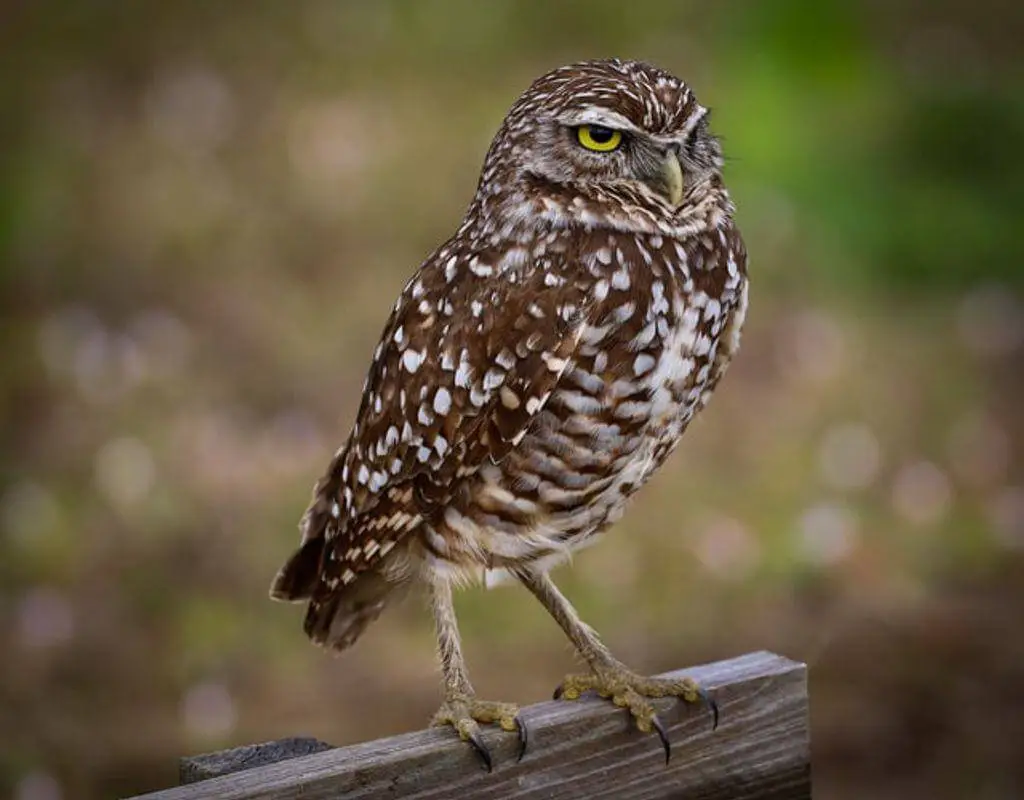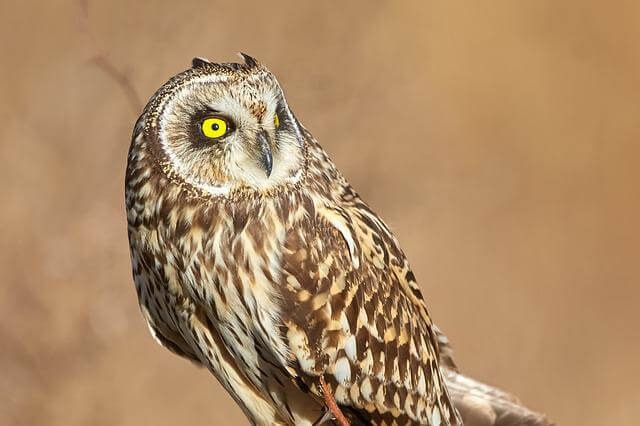Minnesota is home to a dozen owl species. Some are common, others quite rare. Here is an introduction to the 12 owls in Minnesota, with photos for identification, maps, sounds, as well as frequency of occurrence, and tips on how to identify them.
Table of Contents
Types of Owls in Minnesota
Barred Owl
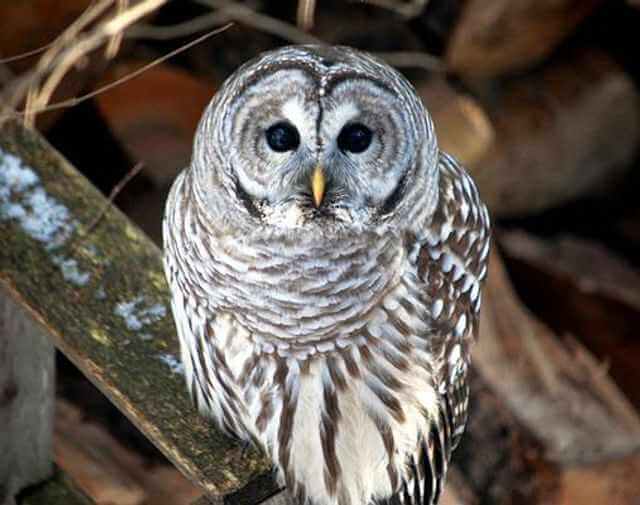
- Length: 17.0-19.7″ in (43-50 cm)
- Weight: 16.6-37.0 oz. (470-1050 g)
- Wingspan: 39.0-43.3″ in (99-110 cm)
- Scientific Name: Strix varia
- Frequency of Occurrence: 1.48% (Statistic by: eBird)
- Where To Find Them: In Minnesota, they are most commonly found in the northern part of the state, but they can also be found in other areas, such as near Minneapolis and Saint Paul.
- How to Attract: If you want to attract barred owls, you can place a nest box in your yard. Barred owls typically use old hawk or crow nests, but they will also use man-made nest boxes. You can make a simple nest box out of a wooden crate with a hole cut in the side or purchase a pre-made one. Be sure to place the nest box in an open area near some trees so the owl has somewhere to perch. You can also help attract barred owls by putting up perches in your yard.
General Information: The barred owl is a large owl that measures about 20inches in length and has a wingspan of up to 44 inches. This species is found in North America, Central America, and South America. In the United States, the barred owl is found in the eastern half of the country, from Maine to Florida and west to Texas.
The barred owl prefers dense woods near water, but can also be found in open fields and forest edges. This owl eats a variety of animals, including rodents, rabbits, snakes, amphibians, fish, and birds. The barred owl builds its nest in a tree cavity or on a platform of sticks.
Great Horned Owl

- Length: 18.1-24.8 in (46.5-63 cm)
- Weight: 32.1-88.2 oz. (910-2500 g)
- Wingspan: 39.8-57.1 in (101-145 cm)
- Scientific Name: Bubo virginianus
- Frequency of Occurrence: 1.35%
- Where To Find Them: In Minnesota, they are most commonly found in the northern part of the state near the Canadian border. However, they can also be found in other parts of the state including the Twin Cities metro area.
- How to Attract: The great horned owl is an interesting bird to observe and can be found in many different habitats. They are attracted to areas where they can find food, but there are some ways to attract them without food. One way is to provide a water source, as they like to drink and bathe. You can also create an owl nesting box or platform to give them a place to live. Place it in an open area where there is plenty of trees for them to perch on. Finally, make sure you keep your yard clean and free of debris, as these owls like to hunt small animals like rodents.
General Information: The great horned owl is one of the most widespread raptors in the world. They are widespread in North and South America, Europe, Africa, and Asia. They are found across the country in the United States. The great horned owl is a large bird with a wingspan of up to 5 feet.
Their plumage is brown or gray and their feathers have white spots. They have large eyes and a distinctive “horned” head. The great horned owl is a carnivore and eats small mammals, birds, reptiles, and amphibians. They nest in trees or on cliffs and lay 2-4 eggs.
Related Post: 35 Fun Facts About The Great Horned Owl (Detailed)
Great Gray Owl
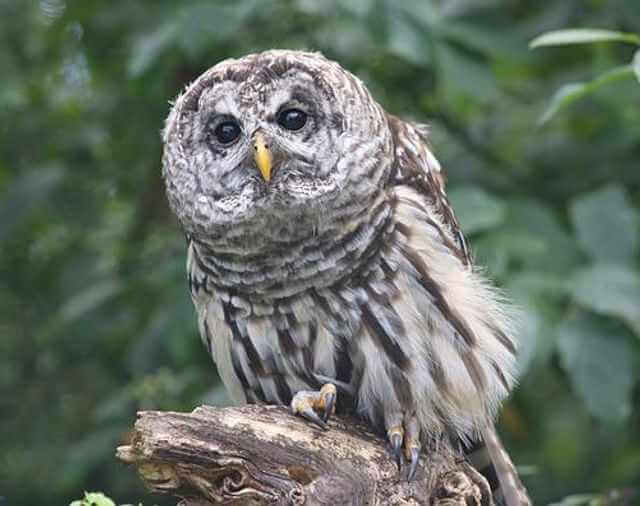
- Length: 24.0-33.0 in (61-84 cm)
- Weight: 24.7-60.0 oz. (700-1700 g)
- Wingspan: 53.9-60.2 in (137-153 cm)
- Scientific Name: Strix nebulosa
- Frequency of Occurrence: 0.4108%
- Where To Find Them: The best locations to see Great Gray Owls in Minnesota are along the North Shore, around Ely, and in Itasca State Park.
- How to Attract: The best way to attract these owls is by providing them with a suitable habitat. Great Gray Owls prefer large areas of forest with plenty of mature trees. They also need a good supply of prey animals in the area.
General Information: The Great Gray Owl is a large owl that is found in North America and parts of Europe. In North America, the Great Gray Owl is found in Canada, Alaska, and the northern United States. The Great Gray Owl is also found in some parts of Europe. In Europe, the Great Gray Owl is found in Scandinavia and Russia.
The Great Gray Owl lives in many different types of habitats, including forests, wetlands, and tundra. The diet of the Great Gray Owl includes small mammals, such as mice and voles, as well as birds and insects. The Great Gray Owl nests in tree cavities or abandoned nests made by other animals.
Related Post: 53 Fun Facts About The Great Gray Owl (Photos, ID & Info)
Snowy Owl
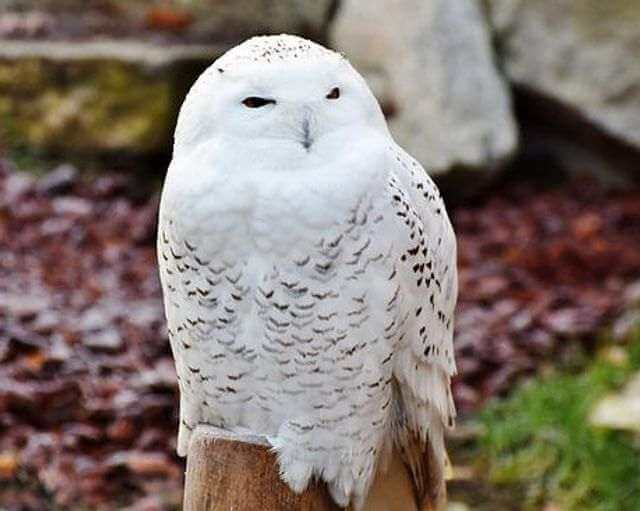
- Length: 20.5-27.9 in (52-71 cm)
- Weight: 56.4-104.1 oz. (1600-2950 g)
- Wingspan: 49.6-57.1 in (126-145 cm)
- Scientific Name: Bubo scandiacus
- Frequency of Occurrence: 0.3980%
- Where To Find Them: The best time to see them is during the winter when they are hunting for food. They can usually be found near open fields or shorelines where they can find small rodents to eat. Some good places to look for them include the Twin Cities, Rochester, Duluth, and along the North Shore.
- How to Attract: There’s no need to offer food to attract a Snowy Owl, as these beautiful birds are naturally drawn to areas where there is plenty of prey. However, you can create an inviting habitat for them by providing some key features. First, look for a location with open fields or wetlands nearby, as Snowy Owls prefer wide-open spaces. Then, make sure the area has plenty of trees and other perches for the owls to roost in. Finally, keep the grass and vegetation short so the owls can easily see their prey. If you can provide all these things, you may be lucky enough to spot a Snowy Owl in your backyard!
General Information: Snowy Owls are native to the Arctic regions of North America and Eurasia. In North America, their range extends from Alaska to Newfoundland, and in Eurasia, their range extends from Iceland and Northern Scandinavia to the Russian Far East. In winter, Snowy Owls may be found as far south as Oregon, Texas, Florida, and even Cuba.
Snowy Owls typically inhabit open country near tundra or taiga. They are opportunistic feeders and will take a variety of prey, including lemmings, voles, hares, ducks, geese, shorebirds, pigeons, and other small birds. They also eat small mammals such as rabbits and rodents. Snowy Owls build their nests on the ground near open water sources such as lakes or wetlands.
Related Post: 48 Fun Facts About Snowy Owls (with Photos, ID & Info)
Northern Hawk Owl
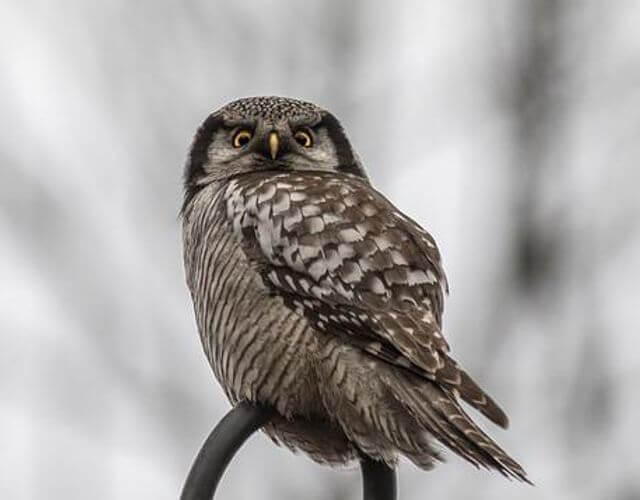
- Length: 14.2-17.7 in (36-45 cm)
- Weight: 8.5-16.0 oz. (240-454 g)
- Wingspan: 27.9 in (71 cm)
- Scientific Name: Surnia ulula
- Frequency of Occurrence: 0.2788%
- Where To Find Them: The Northern Hawk Owl is a migratory bird that can be found in many areas or locations in Minnesota during different times of the year. In the winter, they can be found in the Arrowhead region and the northwestern part of the state. During the spring and summer, they can be found in central and southern Minnesota.
- How to Attract: Northern Hawk Owls can be attracted without providing any food. One way to accomplish this is to create a nesting box. The best time to put up a nest box is in the late winter or early spring before the birds arrive in your area. You can find plans for building a Northern Hawk Owl nest box online. Another way to attract these owls is by creating a perch for them. A good place to put up a perch is near some trees or large bushes.
General Information: The Northern Hawk Owl (Surnia ulula) is a medium-sized owl that ranges throughout the boreal forests of North America and Eurasia. In North America, they are found as far south as central California, and as far north as the treeline in the Arctic tundra.
They are well adapted to living in dense forest habitats, where they can be difficult to see despite their size. Northern Hawk Owls hunt small mammals such as rodents and rabbits, but will also take birds, reptiles and amphibians. They typically nest in trees cavity or on top of large branches.
Eastern Screech-owl
- Length: 6.3-9.8″ in (16-25 cm)
- Weight: 4.3-8.6 oz. (121-244 g)
- Wingspan: 18.9-24.0″ in (48-61 cm)
- Scientific Name: Megascops asio
- Frequency of Occurrence: 0.1465%
- Where To Find Them: Some specific locations where you might find eastern screech-owls include Voyageurs National Park, the Superior National Forest, and along the Mississippi River Valley.
- How to Attract: Eastern screech-owls are attracted to areas that have plenty of prey. If you want to attract these owls to your backyard, you don’t need to provide them with food. Instead, try to create a habitat that is hospitable for prey animals. This could mean adding features like trees, shrubs, and brush piles to your yard. You can also make sure there is a water source available. If you provide these owls with a place to live and hunt, they will likely move in.
General Information: Eastern screech-owls are one of the smallest owl species in North America. They can be found in wooded areas throughout most of the eastern United States, from as far north as Maine and as far south as Florida. They prefer to live in deciduous or mixed forests, but can also be found in suburban areas near parks or woods.
Eastern screech-owls eat a variety of small animals, such as insects, rodents, birds, reptiles, and amphibians. They typically hunt at night, but can also be active during the day. They nest in tree cavities, often using abandoned nests made by other birds. Females lay 2-8 eggs and both parents help care for the young.
Northern Saw-whet Owl
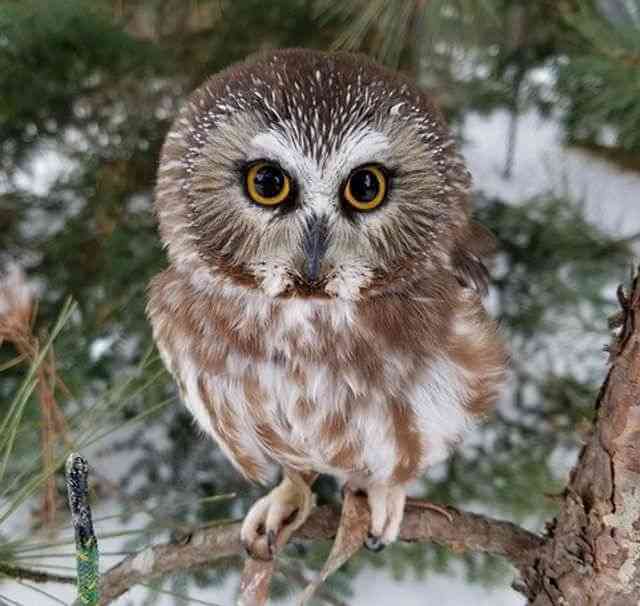
- Length: 7.1-8.3 in (18-21 cm)
- Weight: 2.3-5.3 oz. (65-151 g)
- Wingspan: 16.5-18.9 in (42-48 cm)
- Scientific Name: Aegolius acadicus
- Frequency of Occurrence: 0.1144%
- Where To Find Them: The best places to see northern saw-whet owls in Minnesota include Voyageurs National Park, Isle Royale National Park, Superior National Forest, and the Boundary Waters Canoe Area Wilderness. These owls can also be spotted in other locations around the state, including Grand Marais, Ely, Tower, and Cook County.
- How to Attract: These owls can be attracted to your backyard without providing any food by creating an artificial roosting site. A good place to start is by putting up a dead tree or large branch in your yard. You can also create a roosting box out of wood or metal. The box should be around 12 inches wide by 18 inches high with a hole on the side or top for the owl to enter. Be sure to put the box in a dark, quiet area away from predators and disturbances.
General Information: The Northern Saw-whet Owl is a small owl that is found in North America. It is the smallest owl in North America and has a wingspan of about 18 inches. The Northern Saw-whet Owl is a migratory bird and can be found in Canada, the United States, and Mexico.
The Northern Saw-whet Owl prefers dense forests with plenty of trees for nesting and roosting. The diet of the Northern Saw-whet Owl consists of small rodents, such as mice and rats, as well as insects. The Northern Saw-whet Owl nests in tree cavities or abandoned nests made by other birds.
Related Post: What is the Smallest Owl in North America?
Short-eared Owl
- Length: 13.4-16.9 in (34-43 cm)
- Weight: 7.3-16.8 oz. (206-475 g)
- Wingspan: 33.5-40.5 in (85-103 cm)
- Scientific Name: Asio flammeus
- Frequency of Occurrence: 0.0935%
- Where To Find Them: They have been spotted in a variety of locations including the Dakota Grasslands, The Itasca State Park, and along the Mississippi River.
- How to Attract: There are a few things you can do to attract these owls. One way to attract Short-eared Owls is to provide them with a roosting site. You can do this by placing a large, flat rock on a tree stump or by creating a nest box out of wood. Make sure the opening of the nest box is at least 12 inches wide and 6 inches high. You can also provide Short-eared Owls with cover by leaving dead trees or branches on your property. This will give the owls a place to hide from predators and prey.
General Information: The short-eared owl is a medium-sized raptor that ranges throughout North America, Europe, and Asia. They inhabit open grasslands, prairies, and agricultural areas where they hunt small mammals and birds.
These owls are opportunistic predators and will also consume insects, amphibians, and reptiles. They nest on the ground in open areas near a food source. Breeding takes place in the spring and summer months, and typically two eggs are laid. The young owls fledge around six weeks after hatching.
Boreal Owl
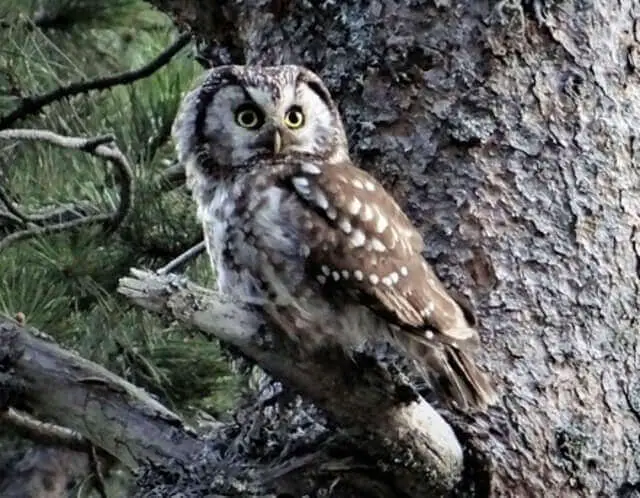
- Length: 8.3-11.0 in (21-28 cm)
- Weight: 3.3-7.6 oz (93-215 g)
- Wingspan: 21.6-24.4 in (55-62 cm)
- Scientific Name: Aegolius funereus
- Frequency of Occurrence: 0.0714%
- Where To Find Them: They are also found in the Boundary Waters Canoe Area Wilderness and the Superior National Forest.
- How to Attract: There are several ways to attract boreal owls without food. One way is to provide a perch for them near a clearing. This can be done by installing a pole with a platform or branch near the edge of a forest, or by placing an artificial tree in an open area. Another way to attract boreal owls is to erect nest boxes near their preferred habitat. Finally, you can also play recordings of their calls to bring them in closer.
General Information: The Boreal Owl (Aegolius funereus) is a medium-sized owl that is found in North America and much of Eurasia. The Boreal Owl is the most northerly distributed owl in the world. It is also the most widespread owl in North America. The Boreal Owl inhabits boreal forests and mixed woodlands.
It is also found in open country near wetlands. The diet of the Boreal Owl consists of small mammals, such as voles, mice, and shrews. It also eats birds, including passerines and woodpeckers. The nesting habits of the Boreal Owl are not well known.
Long-eared Owl
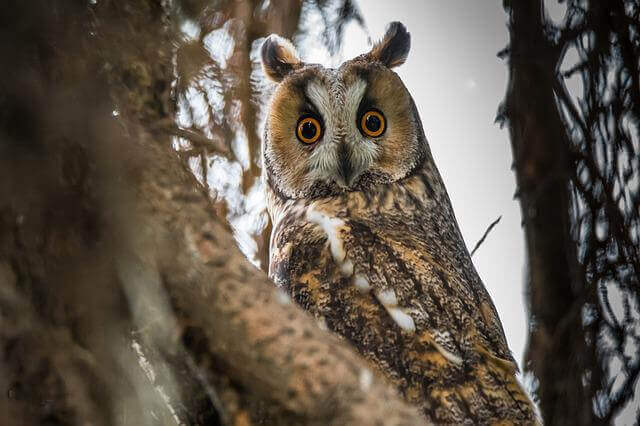
- Length: 13.8-15.8 in (35-40 cm)
- Weight: 7.8-15.3 oz. (220-435 g)
- Wingspan: 35.4-39.4 in (90-100 cm)
- Scientific Name: Asio otus
- Frequency of Occurrence: 0.0680%
- Where To Find Them: There are several locations in Minnesota where you can find the long-eared owl. One is near Forestville/Mystery Cave State Park, where the bird can be seen perched along the edge of a forest. Another place to spot the owl is near Tamarac National Wildlife Refuge, where they can often be seen perched in tall trees or hunting along the edges of marshes. In late winter and early spring, look for these owls near open water areas, such as lakes and ponds.
- How to Attract: One way to attract these owls is by providing them with a perch or nesting box. You can also try to create an environment that is similar to their natural habitat. This includes providing a safe place for them to hunt and live. It is important not to feed these owls, as it can disrupt their natural feeding habits.
General Information: Long-eared owls are typically found in open woodlands, preferring locations with plenty of large trees. They can also be spotted in grasslands, deserts, and shrublands. These owls mostly eat small mammals such as voles, mice, rats, and rabbits.
They will also consume birds, insects, and amphibians on occasion. Long-eared owls build their nests in tree cavities or on ledges. Females lay between 2 and 7 eggs per clutch. The eggs hatch after about 28 days, and the young owlets fledge at around 5 weeks old.
Barn Owl
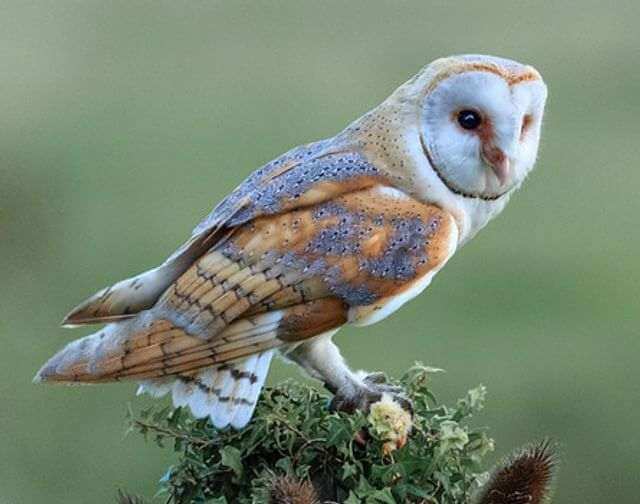
- Length: 12.6-15.8″ in (32-40 cm)
- Weight: 14.1-24.7 oz. (400-700 g)
- Wingspan: 39.4-49.2″ in (100-125 cm)
- Scientific Name: Tyto alba
- Frequency of Occurrence: 0.0034%
- Where To Find Them: They are typically found in the open agricultural areas of the state, as well as in the forests near the Canadian border. In recent years, they have been spotted more frequently in the Twin Cities metropolitan area.
- How to Attract: There are several things you can do to attract barn owls. One is to provide a roosting box. Barn owls like to nest in tall trees, but if there are no tall trees available, they will use a box instead. You can also provide a perch for the owls to sit on. This can be something as simple as a branch or a wooden post. You can also make your yard more owl-friendly by providing some cover.
General Information: The barn owl is a common and widespread bird that can be found throughout most of the world. They typically inhabit open areas such as fields, meadows, and marshes, but they can also be found in forest edges and even in some urban areas. Barn owls are night hunters and feed on small rodents, such as mice, voles, and rats. They also eat other small prey items, such as insects and frogs. Barn owls nest in a variety of locations, including tree cavities, old buildings, caves, and barns.
Burrowing Owl
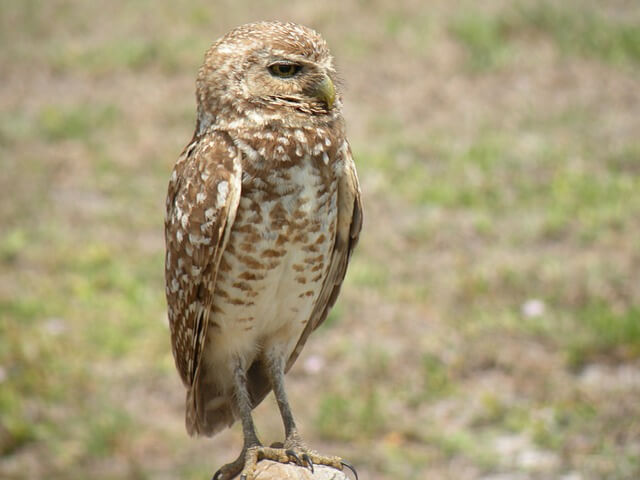
- Length: 7.5-9.8″ in (19-25 cm)
- Weight: 5.3 oz. (150 g)
- Wingspan: 21.6″ in (55 cm)
- Scientific Name: Athene cunicularia
- Frequency of Occurrence: 0.0010%
- Where To Find Them: The Burrowing Owl is a small owl that can be found in parts or locations of Minnesota. They are common in the southwestern part of the state, and have also been seen in other areas such as Rochester, Detroit Lakes, and Duluth. The Burrowing Owl usually lives in open areas near prairies, farmland, or golf courses.
- How to Attract: You can attract them to your yard without providing food by adding a water source such as a bird bath and placing some rocks or logs in the area for them to perch on. The owls will also benefit from having some protective cover nearby, such as a shrub or hedge.
General Information: Burrowing Owls are found in open country and grasslands in western North America. They live in prairies, farmlands, and deserts. They also live near towns and cities. The Burrowing Owl is the only owl that lives in underground burrows.
It digs its own burrow or uses a hole made by a gopher, ground squirrel, or badger. The Burrowing Owl eats small mammals such as mice, rats, and voles. It also eats insects such as grasshoppers and crickets. The Burrowing Owl nests in underground burrows. Learn more: Really Cool Burrowing Owl Facts That Will Amaze You!
Related Post: 34 Most Common Backyard Birds In Minnesota (Detailed)

